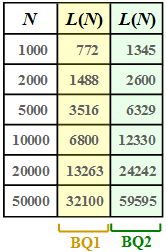Exercise 2.5Z: Compression Factor vs. Residual Redundancy
From LNTwww
As in exercise 2.5 we consider data compression using the Lempel–Ziv–Welch–algorithm. Here holds:
- Let the input sequence have length $N$.
- The length of the LZW coder output is $L$.
The graph shows for two different binary sources $\rm BQ1$ and $\rm BQ2$ the relationship between the sequence lengths $N$ and $L$, represented by the function $L(N)$.
The two message sources have the same statistical properties as in exercise 2.5:
- $\rm BQ1$ is redundant due to unequal symbol probabilities $(p_{\rm A} = 0.89$ and $p_{\rm B} = 0.11)$ . There are no ties between the individual symbols. The entropy is $H = 0.5$ bit/source symbol.
- $\rm BQ2$ is redundancy-free and thus has entropy $H = 1$ bit/source symbol.
Furthermore, you need two definitions for the solution of this task:
- Let the compression factor be by definition
- $$K(N) = \frac{L(N)}{N}\hspace{0.05cm}.$$
- The relative redundancy of the LZW code sequence (called residual redundancy in the following) is
- $$r(N) = \frac{L(N) - N \cdot H}{L(N)}= 1 - \frac{ N \cdot H}{L(N)}\hspace{0.05cm}.$$
Hints:
- The task belongs to the chapter Compression according to Lempel, Ziv and Welch.
- In particular, reference is made to the pages
Questions
Musterlösung
(1) Der Komprimierungsfaktor ist definiert als der Quotient der Längen von LZW–Ausgangsfolge $(L)$ und Eingangsfolge $(N = 10000)$:
- $${\rm BQ1:}\hspace{0.3cm} K \hspace{0.2cm} = \hspace{0.2cm} \frac{6800}{10000}\hspace{0.15cm}\underline{= 0.680}\hspace{0.05cm},$$
- $$ {\rm BQ2:}\hspace{0.3cm} K \hspace{0.2cm} = \hspace{0.2cm} \frac{12330}{10000}\hspace{0.15cm}\underline{= 1.233}\hspace{0.05cm}. $$
- Die LZW–Codierung macht natürlich nur bei der redundanten Binärquelle $\rm BQ1$ Sinn. Hier kann die Datenmenge um $32\%$ gesenkt werden.
- Bei der redundanzfreien Binärquelle $\rm BQ2$ führt dagegen die LZW–Codierung zu einer um $23.3\%$ größeren Datenmenge.
(2) Aus der angegebenen Gleichung erhält man mit $N = 10000$:
- $${\rm BQ1:}\hspace{0.3cm} H = 0.5\hspace{0.05cm},\hspace{0.2cm} r(N=10000) \hspace{0.2cm} = \hspace{0.2cm}1 - \frac{0.5 \cdot N}{L } = 1 - \frac{5000}{6800 } \hspace{0.15cm}\underline{\approx 26.5\,\%}\hspace{0.05cm},$$
- $$ {\rm BQ2:}\hspace{0.3cm} H = 1.0\hspace{0.05cm},\hspace{0.2cm} r(N=10000) \hspace{0.2cm} = \hspace{0.2cm}1 - \frac{N}{L } = 1 - \frac{10000}{12330 } \hspace{0.15cm}\underline{\approx 19\,\%}\hspace{0.05cm}.$$
- Die Restredundanz gibt die (relative) Redundanz der LZW–Ausgangsfolge an.
- Obwohl die Quelle $\rm BQ1$ für die LZW–Codierung besser geeignet ist als die redundanzfreie Quelle $\rm BQ2$, ergibt sich bei $\rm BQ1$ wegen der Redundanz in der Eingangsfolge eine größere Restredundanz.
- Eine kleinere Restredundanz $r(N)$ bei gegebenem $N$ sagt also nichts darüber aus, ob die LZW–Codierung für die vorliegende Quelle sinnvoll ist.
- Hierzu muss der Komprimierungsfaktor $K(N)$ betrachtet werden. Allgemein gilt folgender Zusammenhang zwischen $r(N)$ und $K(N)$:
- $$r(N) = 1 - \frac{H}{K(N)}\hspace{0.05cm},\hspace{0.5cm} K(N) = H \cdot (1- r(N)) \hspace{0.05cm}.$$
(3) Aus der Tabelle auf der Angabenseite kann man ablesen (bzw. daraus ableiten)
- für die redundante Binärquelle $\rm BQ1$:
- $$L(N = 50000) = 32100\hspace{0.05cm},\hspace{0.5cm} K(N = 50000) = 0.642\hspace{0.05cm},\hspace{0.5cm}r(N = 50000) \hspace{0.15cm}\underline {= 22.2\,\% \hspace{0.05cm}},$$
- für die redundanzfreie Binärquelle $\rm BQ2$:
- $$L(N = 50000) = 59595\hspace{0.05cm},\hspace{0.5cm} K(N = 50000) = 1.192\hspace{0.05cm},\hspace{0.5cm}r(N = 50000) \hspace{0.15cm}\underline {= 16.1\,\% \hspace{0.05cm}}.$$
Richtig sind somit die Aussagen 1 und 2:
- Für beide Quellen ist der Komprimierungsfaktor $K(N)$ für $N = 50000$ kleiner als für $N = 10000$.
- Gleiches gilt für die Restredundanz: $r(N = 50000) < r(N = 10000)$.
- Sowohl hinsichtlich $K(N)$ als auch hinsichtlich $r(N)$ ergeben sich also bei größerem $N$ "günstigere" Werte, auch dann, wenn eigentlich wie bei der redundanzfreien Binärquelle $\rm BQ2$ die Anwendung von Lempel–Ziv zu einer Verschlechterung führt.
